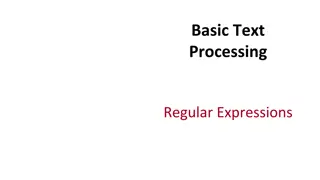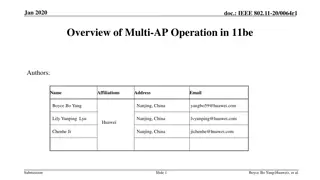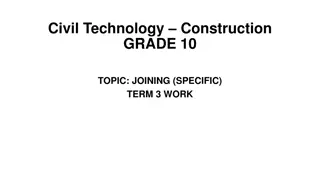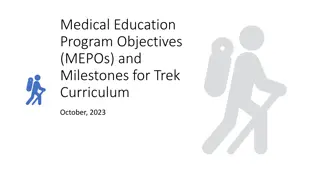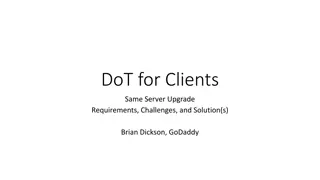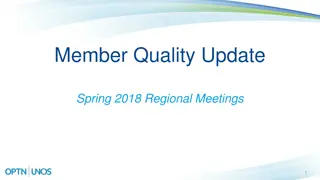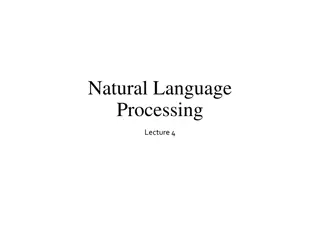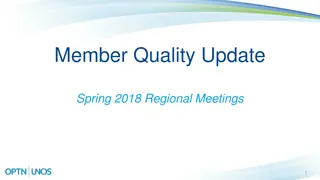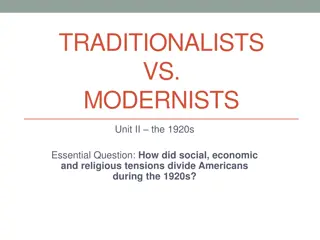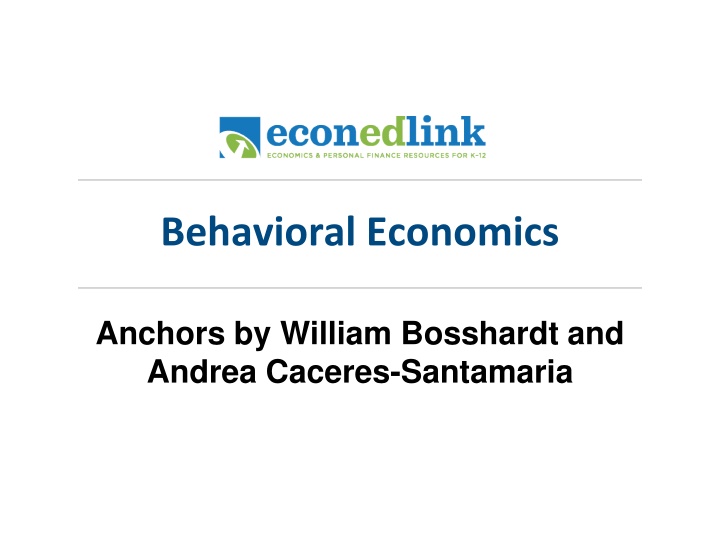
Anchoring Effects in Behavioral Economics
Explore the concept of anchoring effects in behavioral economics through a unique market activity involving buyers and sellers. Learn about cognitive biases, the anchoring effect, and how initial information influences decision-making. Discover how anchoring can impact pricing strategies and buyer behavior.
Uploaded on | 1 Views
Download Presentation

Please find below an Image/Link to download the presentation.
The content on the website is provided AS IS for your information and personal use only. It may not be sold, licensed, or shared on other websites without obtaining consent from the author. If you encounter any issues during the download, it is possible that the publisher has removed the file from their server.
You are allowed to download the files provided on this website for personal or commercial use, subject to the condition that they are used lawfully. All files are the property of their respective owners.
The content on the website is provided AS IS for your information and personal use only. It may not be sold, licensed, or shared on other websites without obtaining consent from the author.
E N D
Presentation Transcript
Behavioral Economics Anchors by William Bosshardt and Andrea Caceres-Santamaria
Activity Sellers are represented by a letter and buyers by a number. Write your number or letter on your badge. This is how you will be identified in the market. Affix your badge onto your clothing (with a pin, tape, or clip) so that buyers and sellers can be identified. Quietly read the information sheet that explains your role as a seller or buyer. Keep the information on this sheet to yourself. Buyers, pay close attention and be sure to follow the instructions as there is some information you need to fill out. Slide 2.1 Anchors 2 www.EconEdLink.org
Activity cont.. The good that is being sold/purchased in this market is a textbook. All sellers have the same textbook and all buyers need to purchase the same textbook. Once a buyer and seller communicate, you can only make a deal with that specific other person. No shopping around is permitted! Use the transaction sheet provided to record the final price paid. Modified from Designing Choice: The Default and Anchoring, Written by Craig Zdanowicz Slide 2.2 Anchoring 3 www.EconEdLink.org
Definitions What is a cognitive bias? Cognitive bias can be characterized as the tendency to make decisions and take action based on limited acquisition and/or processing of information or on self-interest, overconfidence, or attachment to past experience. Anchoring Effect: Anchoring is a type of cognitive bias that people exhibit in which there is a tendency to rely significantly on the first piece of information that is given or available when making a decision. Slide 2.3 Anchoring Effect: Modified from Designing Choice: The Default and Anchoring: Written by Craig Zdanowicz http://ux.saggezza.com/articles/designing-choice-the-default-and-anchoring/ Cognitive Bias: Cognitive Biases Are Bad for Business Do you see irrationality in your company? Jim Taylor Ph.D.: https://www.psychologytoday.com/blog/the-power-prime/201305/cognitive-biases-are-bad-business Anchoring 4 www.EconEdLink.org
Example Initially we do not know what value the textbook has in terms of price. Once the buyers were anchored to consider a specific value (which in this case was considering their buyer number as a price), they were able to more easily offer a price for the textbook. Without having been asked to consider a price for the book, the buyers may not have known what they should pay for the book. Slide 2.4 Anchors 5 www.EconEdLink.org
Example cont. As long as they have a price that they can anchor their expectations to, whether it be their buyer number or a price for that textbook from a different student, bookstore, or online retailer, buyers have a coherent rationale for why they would pay that price or somewhere in the range of the original price that was initially seen. The price becomes a point of reference for all other future decisions on what price to pay. Slide 2.5 Modified from Designing Choice: The Default and Anchoring, Written by Craig Zdanowicz Anchors 6 www.EconEdLink.org
Relativity trap Consumers think about prices relative to a benchmark and retailers are aware of this. Retailers set a manufacturer s suggested retail price (MSRP) as a benchmark, and then discount the actual price. Consumers then evaluate the posted price relative to the MSRP. Slide 2.6 Modified from: Why We Buy: How to Avoid 10 Costly Cognitive Biases. See more at: http://www.spring.org.uk/2011/03/why-we-buy-how-to-avoid-10-costly-cognitive- biases.php#sthash.f5DD4lKp.dpuf Author: Dr. Jeremy Dean Anchors 7 www.EconEdLink.org
Relativity trap The relativity trap is an example of the anchoring effect. The MSRP price acts like an anchor in how we think about whether or not we are getting a good deal. Manufacturer's have an intended outcome for the sales price they receive for their goods; they anchor us to a higher price to make any amount lower seem like a good deal, or as we call it, a discount. Slide 2.7 Modified from: Why We Buy: How to Avoid 10 Costly Cognitive Biases. See more at: http://www.spring.org.uk/2011/03/why-we-buy-how-to-avoid-10-costly-cognitive- biases.php#sthash.f5DD4lKp.dpuf Author: Dr. Jeremy Dean Anchors 8 www.EconEdLink.org
Is this ATV Expensive? $6,500 from www.atvtraderonline.com Suzuki Kingquad 500axi ATVs for sale Slide 2.8 Anchors 9 www.EconEdLink.org
How about now? $6,500 MSRP$8,299 from www.atvtraderonline.com Suzuki Kingquad 500axi ATVs for sale Slide 2.9 Anchors 10 www.EconEdLink.org
And now? $6,500 MSRP$8,299 from www.atvtraderonline.com Suzuki Kingquad 500axi ATVs for sale Slide 2.10 Anchors 11 www.EconEdLink.org
Comparing Econs and Humans Lesson 1 Econs Humans Use system 2 for all their decisions. Use system 1 to make many routine decisions. Carefully weigh costs and benefits to make decisions. Are not subject to cognitive biases when making decisions. Make decisions on past experience or quick judgments. Are subject to cognitive biases when making decisions and so may use anchors and fall into relativity traps. 2 3 Make decisions by weighing costs and benefits equally. Are not influenced by their current situation when making decisions. Tend to weigh losses greater than gains. Tend to bias to the default or to things they already have. 4 May discount costs and benefits that occur in the future. May have self-control problems and discount the future too much or be subject to present bias, causing inconsistent decisions. May make decisions based on fairness or for other emotional factors such as whether work is meaningful. 5 Only use costs and benefits to make decisions. Anchors 12 www.EconEdLink.org
Can we avoid being anchored? When you go shopping, know the value (benefit) to you of any good you would consider purchasing. Research and know the approximate price of the good in the market so that you can recognize when a discount is really a discount and not just a marketing ploy. Be aware that you can be influenced by anchors provided by retailers. You can reset the anchor by walking away from negotiations. You can set the anchors by making first offers. Slide 2.12 Anchors 13 www.EconEdLink.org
Can we avoid being anchored? If you see that a retailer is trying to anchor you on a high initial price, ask yourself, do I actually value this at more than the sales price, or is the seller just trying to make this seem like a good deal in comparison to the original price? If consumers are less impulsive and more cautious and conscious about the price they pay, they can be less influenced by sellers attempts to anchor them on high prices in the guise of making something appear to be a good deal. Slide 2.13 Modified from Designing Choice: The Default and Anchoring: Written by Craig Zdanowicz Anchors 14 www.EconEdLink.org
Are random anchors that powerful? Study conducted by Tversky and Kahneman (1974) A random number was generated by spinning a wheel in view of the participants. Participants were asked to tell whether this random number was higher or lower than the percentage of African nations in the United Nations. Judgment under Uncertainty: Heuristics and Biases, Amos Tversky; Daniel Kahneman, Science, New Series, Vol. 185, No. 4157. (Sep. 27, 1974), pp. 1124-1131. Anchors 15 www.EconEdLink.org
Are random anchors that powerful? Participants were asked to estimate the percentage of African nations in the United Nations. Suppose group A saw a random number of 10 and group B saw a random number of 65. Was group A s average estimate higher or lower than group B s? How large a difference would you predict? Slide 2.15 Modified from Designing Choice: The Default and Anchoring, Written by Craig Zdanowicz Anchors 16 www.EconEdLink.org
Are random anchors that powerful? Study conducted by Tversky and Kahneman (1974) Median estimate by Group A: 25 Median estimate by Group B: 45 Slide 2.16 Judgment under Uncertainty: Heuristics and Biases, Amos Tversky; Daniel Kahneman, Science, New Series, Vol. 185, No. 4157. (Sep. 27, 1974), pp. 1124-1131. Anchors 17 www.EconEdLink.org





